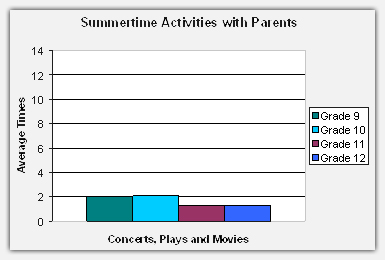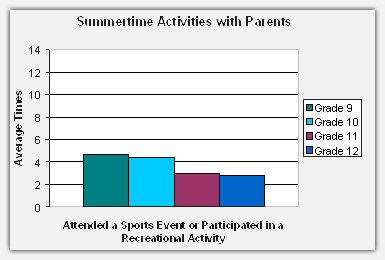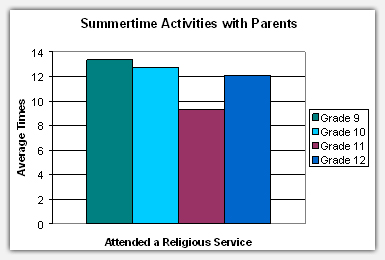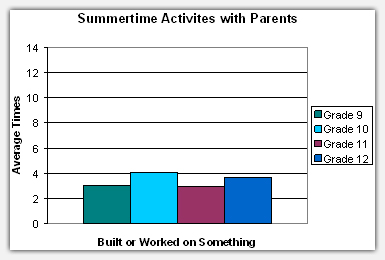Resources > Data Briefs
Spending Quality Time with the Parents
Thursday November 1, 2007

Figure 1
Summertime Activities with Parents
(Concerts, Plays, Movies)

Figure 2
Summertime Activities with Parents
(Sports & Recreational Activities)

Figure 3
Summertime Activities with Parents
(Museums, Zoos, Aquariums, Planetariums, or Botanical Gardens)

Figure 4
Summertime Activities with Parents
(Attended a Religous Service)

Figure 5
Summertime Activities with Parents
(Built or worked on something)
On average, children grow up and pull away from their parents and guardians. They begin to bond with people around their same age. As time goes on, they turn to their friends for support, advice and comfort. This seems to be extremely prevalent during the high school years, perhaps as preparation for moving away to college or becoming a self-sufficient adult. Currently, this is truer than ever as more and more teenagers get a driver’s license, a cell phone, and maybe even a car. Parents are often left wondering what kinds of activities their children will be willing to do with them. Therefore, it could be assumed that as children spend time with their friends in increasing amounts that they, then, spend less time with their parents.
By combining the two cohorts from the Longitudinal Study of American Youth (LSAY), we obtain a representation of freshman through senior years of high school. During the participants’ teenage years, LSAY asked them about various activities they partook in during the summertime with their parents. Some of these activities included: attending plays, concerts, or movies, attending a sports event, built or worked on something together, visited a zoo, museum, aquarium, planetarium or botanical garden together, participated in some recreation like tennis, skating, or swimming, and attended a church or religious service together. From this information, I compiled averages for all four years of high schools of each activity.
Figures 1 through 5 show some interesting patterns. While Figures 1 through 3 show an overall decrease in attending plays, concerts, movies, sports events, and religious services, participating in recreational activities, and visiting zoos, museums, aquariums, planetariums or botanical gardens with parents, Figures 4 and 5 show in increase in attending religious services and interest in building or working on something together during the summer before senior year. Therefore, in the viewpoint of a teenager, it may be cooler to go to the movies, concerts, or sports events with friends, but the results show they are willing to spend time with their parents going to religious events and building or working on something.
The participants in the Longitudinal Study of American Youth are currently in their early- to mid- thirties, and many have children of their own. Even though it seems easy to spend time with children while they are young, as most parents know, teenagers become more difficult, and all children grow up. Clearly all teenagers do not fit into a mold, but trends speak for themselves. Hopefully, this helps prevent new parents from feeling discouraged as their children distance themselves and helps them remember they did the same thing when they were at that age.
Prepared by Mary Mier

